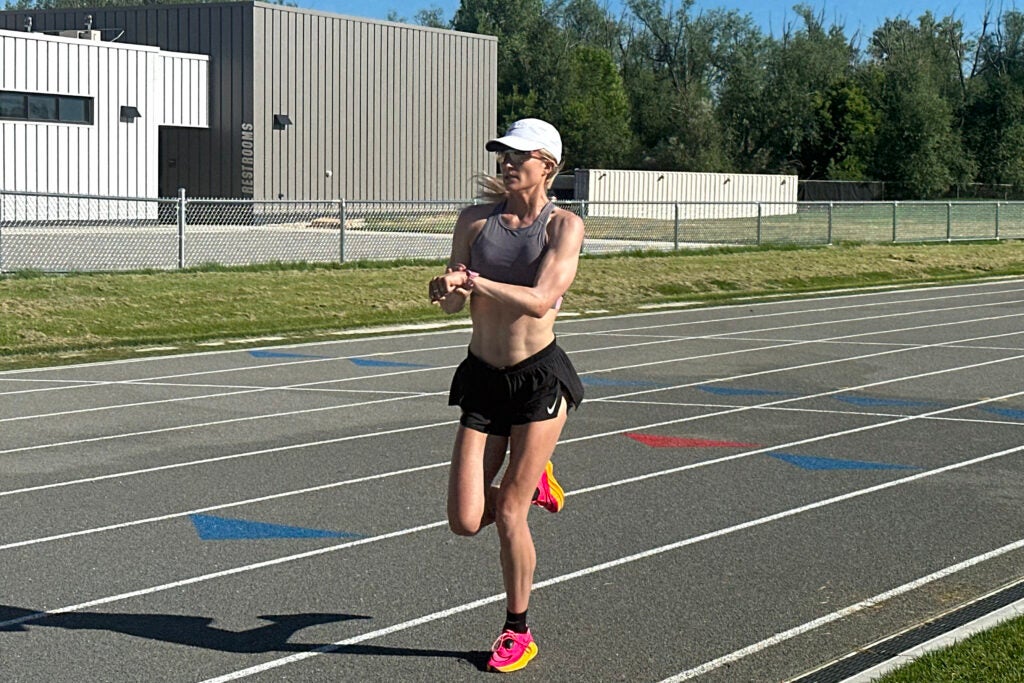Fitness
4 Ways to Tell Your Fitness Is Improving Without Obsessing Over Pace

“], “filter”: { “nextExceptions”: “img, blockquote, div”, “nextContainsExceptions”: “img, blockquote, a.btn, a.o-button”} }”>
New perk: Easily find new routes and hidden gems, upcoming running events, and more near you. Your weekly Local Running Newsletter has everything you need to lace up!
>”,”name”:”in-content-cta”,”type”:”link”}}”>Subscribe today.
One of the most appealing things about running is its objective nature: it’s measured by the clock, or how fast you can run. And if you run more or you run harder, you should get faster. (There’s a reason so many Type A personalities are drawn to the sport.) The problem comes when you start to use pace as the only metric to determine whether you’re getting better at running.
“Pace is not the only way to define a ‘good runner,’ and thinking that takes away from all the other benefits of the sport,” says Victoria Sekely, DPT, a New York City-based certified strength and conditioning specialist and USATF- and RRCA-certified running coach. “It’s a number that can be affected by so many factors, so it won’t constantly improve—even if you are improving as a runner.”
But because pace is the most obvious indicator of performance, runners often get hung up on it, stressing out about being a few seconds too slow during speed work intervals or melting down because holding their long run pace felt more challenging than the previous week. Feeling like your pace needs to be perfect in training creates unrealistically high standards and sets you up for disappointment.
“The negative self-talk spiral begins as soon as you equate certain splits with a good session. Then, the feeling of discouragement can lead to a lack of motivation to perform in your next workout which, in turn, results in less progress over time,” says Amanda Katz, a New York City-based RRCA-certified running coach and NASM-certified personal trainer. “And fixating on your pace or being excessively concerned with hitting certain [number-based] metrics in your workouts is a really good way to form a poor relationship with running and, ultimately, your self-worth.”
Chasing ever-faster paces can often obscure true signs of progress and even lead to burnout. Instead of letting a stopwatch determine your success, consider tuning into the subtler indicators that your fitness is soaring.
1. Your runs feel easier.
You’re really not supposed to hit every single workout on the nose in terms of pace—weather, nutrition, sleep quality, stress levels, and a slew of other variables will affect the numbers on your watch. Effort, however, is a good guideline in determining where your fitness is at, and paying attention to it “really helps you develop that connection with your body so you don’t have to look at your watch all the time,” says Sekely.
Scientists and coaches have used a scale—known as the rate of perceived exertion (RPE)— ranging from 0 to 10, with 0 being no exertion and 10 being the highest level—to subjectively assess effort since the 1960s. But Katz says that you don’t even need to attach numbers to perceived effort to notice improvements in your fitness. Does running uphill feel less daunting than the last time you did it? Is your breath labored, or are you able to hold a conversation more easily? Does sustaining a faster pace feel more manageable? Do the last miles of a long run feel less challenging? Those are all green flags that you’re getting fitter and stronger.
2. Your heart rate improves.
Almost every running watch that tracks pace also tracks heart rate, and this number can be a good gauge of both effort and fitness. During exercise, your heart rate speeds up as your heart—a muscle—works hard to pump enough blood (and oxygen and nutrients) to your other working muscles. “As your heart gets stronger, it’s able to pump more blood throughout your body more efficiently,” says Sekely. Over time, your heart rate will be lower at a given intensity because the muscle isn’t working as hard to sustain that effort.
You can also see cardiovascular gains show up in your resting heart rate, aka the number of times your heart beats per minute when you’re sitting or lying down (usually measured first thing in the morning). “The fitter you are, the more efficient your cardiovascular system gets,” says Sekely. Keep in mind, though, that everyone’s heart rate is unique. Resting heart rate can differ from person to person by as much as 70 beats per minute, a 2020 study published in PLoS One determined. Understanding what’s normal for you will help you track trends in your data.
RELATED: 11 Reasons Your Heart Rate is High on Easy Runs
3. You can run farther.
Most fitness is driven by the principle of progressive overload. Over time, you gradually increase the amount of stress you’re putting on your body. In running, one way you do that is by adding miles or time on your feet. As your body gets used to the stress of running, it’s able to do it more efficiently and tolerate more of it. So even if your pace doesn’t seem to be improving as much as you’d like, a true test of fitness is how long you can run at a time.
“You know your body is responding well when you don’t feel wiped from your runs and you’re stacking weeks of consistent training,” says Katz.
Plus, running more and for longer will eventually make you faster. The volume of easy runs was most correlated with world-class long-distance running performance—compared to tempo runs, long-interval training, and short-interval training—in a 2021 study published in the Journal of Strength and Conditioning Research. Meaning, while tempo runs and short bursts of speed are important for improvement, a steady progression of volume in the form of easy runs are essential for overall performance.
RELATED: What Exactly Is a Tempo Run?
4. You’re recovering quicker.
Speaking of not feeling wiped, how quickly you bounce back from a workout is a great sign that your body is adapting to the demands of running and is becoming more efficient. When you expose your body to a new stressor—like running further than you ever have before or introducing faster paces in a speed workout—it’s normal to feel tired or sore afterward. “That’s an indicator that your muscles are changing,” says Sekely.
Over time, though, as your body becomes accustomed to that distance or those paces, you won’t feel as tired or sore afterward. That doesn’t mean you’ll never feel sore after a workout; intermediate or advanced runners with more experience doing long or hard sessions might not feel the muscular effects as obviously as new runners.
But if you start to notice that you no longer need an extra day between your long run and your next workout, or you’re not still feeling totally gassed the morning after track, that suggests that “you’re running at the appropriate intensity, periodizing your training properly, and eating and sleeping enough,” says Katz—all of which can mean your body is ready and able to handle more training load.







